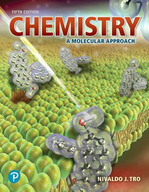?Living organisms use energy from the metabolism of food to create an energy-rich
Chapter 19, Problem 91(choose chapter or problem)
Living organisms use energy from the metabolism of food to create an energy-rich molecule called adenosine triphosphate (ATP). The ATP acts as an energy source for a variety of reactions that the living organism must carry out to survive. ATP provides energy through its hydrolysis, which can be symbolized as follows:
\(\mathrm{ATP}(a q)+\mathrm{H}_{2} \mathrm{O}(l) \longrightarrow \mathrm{ADP}(a q)+\mathrm{P}_{\mathrm{i}}(a q) \quad \Delta G_{\mathrm{rxn}}^{\circ}=-30.5 \mathrm{~kJ}\)
where ADP represents adenosine diphosphate and \(P_{i}\) represents an inorganic phosphate group (such as \(\mathrm{HPO}_{4}^{2-}\) ).
a. Calculate the equilibrium constant, K, for the given reaction at 298 K.
b. The free energy obtained from the oxidation (reaction with oxygen) of glucose \(\left(\mathrm{C}_{6} \mathrm{H}_{12} \mathrm{O}_{6}\right)\) to form carbon dioxide and water can be used to re-form ATP by driving the given reaction in reverse. Calculate the standard free energy change for the oxidation of glucose and estimate the maximum number of moles of ATP that can be formed by the oxidation of one mole of glucose.
Text Transcription:
ATP(aq) + H2O(l) longrightarrow ADP(aq) + Pi(aq) ∆G° rxn = -30.5 kJ
P_i
HPO4 2 -
Unfortunately, we don't have that question answered yet. But you can get it answered in just 5 hours by Logging in or Becoming a subscriber.
Becoming a subscriber
Or look for another answer
